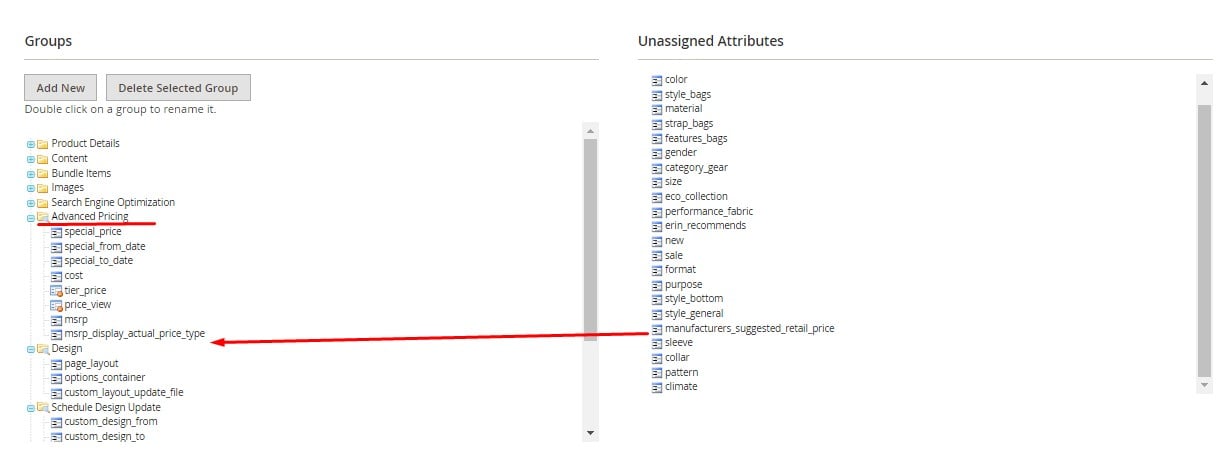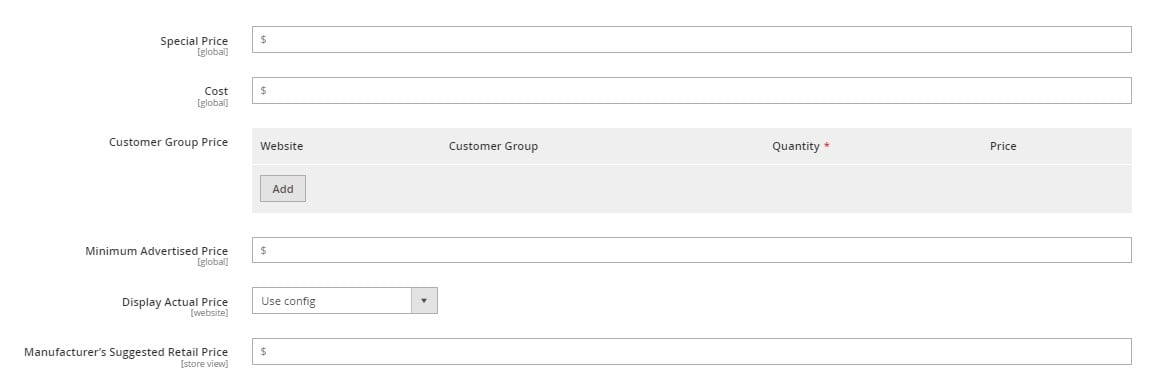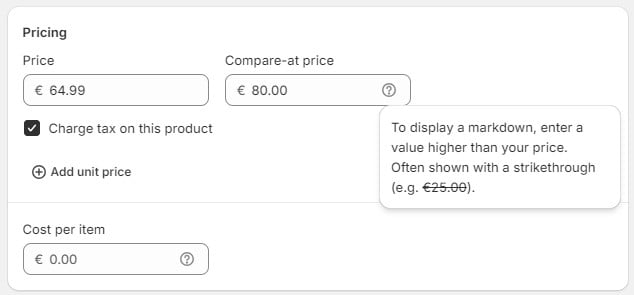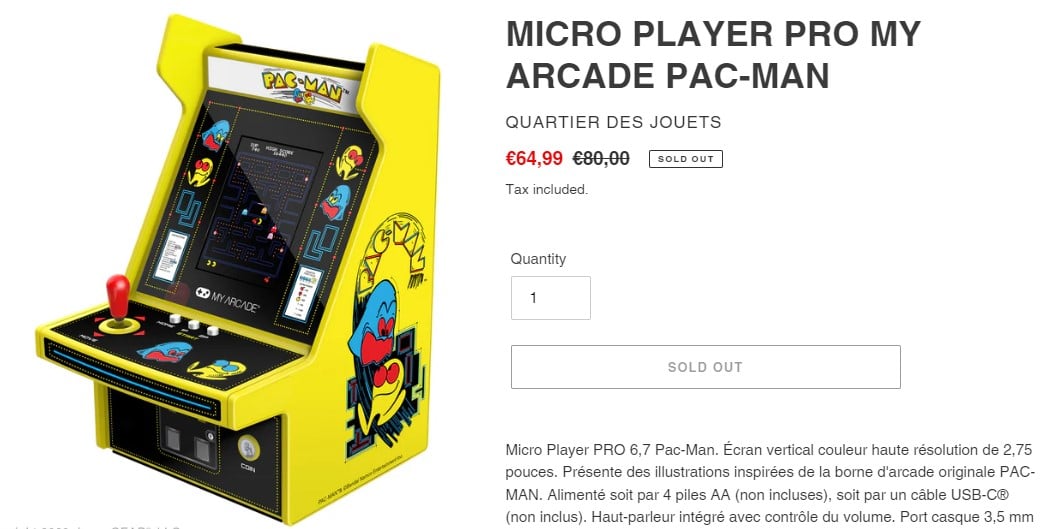MSRP Meaning Uncovered: A Complete Guide to Manufacturer’s Suggested Retail Price in E-Commerce

Understanding the MSRP meaning is key to navigating the world of e-commerce pricing. The Manufacturer’s Suggested Retail Price is more than just a number — it’s a powerful tool that brings order to the chaos.
While some retailers might choose to price above or below the MSRP, this figure plays a crucial role in maintaining consistent pricing across sellers, preventing cutthroat price wars, and protecting the perceived value of the product.
Whether you’re a shopper curious about that price tag or an e-commerce merchant trying to stay competitive, Manufacturer’s Suggested Retail Price is the silent regulator shaping the online marketplace.
In this guide, we’ll break down what MSRP means, its role in e-commerce, and how platforms like Magento, Shopify, and Shopware help merchants manage it effectively.

Table of contents
- 1 What is MSRP: Why the Manufacturer’s Suggested Retail Price is More Than Just a Number
- 2 MSRP Meaning for E-Commerce: The Pricing Tool You Didn’t Know You Needed
- 3 Problems With MSRP: When the Manufacturer’s Price Tag Becomes a Headache
- 4 MSRP vs. Base Price vs. Invoice Price: Decoding the Pricing Puzzle
- 5 How MSRPs Are Determined: The Science Behind That Price Tag
- 6 MSRP on Major E-Commerce Platforms: Getting Your Price Right Everywhere
- 7 Final Words
- 8 FAQ: Understanding Manufacturer’s Suggested Retail Price
What is MSRP: Why the Manufacturer’s Suggested Retail Price is More Than Just a Number
So, let’s talk about the true MSRP meaning. MSRP, or Manufacturer’s Suggested Retail Price, is exactly what it sounds like — the price a manufacturer suggests a retailer should charge for a product. Think of it as the sticker price on that shiny new laptop or pair of sneakers you’ve been eyeing online. It’s the manufacturer’s polite way of saying, “Hey, we built this, and here’s what we think it’s worth.”
However, just because it’s “suggested” doesn’t mean it’s the law. Retailers can — and often do — sell above or below the MSRP, especially during sales or when they’re trying to get rid of last year’s inventory. But in many cases, the Manufacturer’s Suggested Retail Price helps set a baseline that keeps pricing consistent across different sellers.
The MSRP isn’t just a number pulled out of thin air. It’s carefully calculated based on production costs, market research, and a dash of magic (well, mostly market research). The idea is to reflect the product’s value without scaring customers off.
MSRP, SRP, RRP & List Price: Are They Any Different?
When it comes to pricing, you’ve probably seen a handful of acronyms tossed around — MSRP, SRP, RRP, and even list price. Confused? Don’t worry; they all point to the same thing: the price a manufacturer suggests retailers charge for their product. Let’s break it down:
- MSRP (Manufacturer’s Suggested Retail Price): Most common in the U.S., this is the price a manufacturer recommends for their products, particularly in industries like electronics, cars, and gadgets. It’s the polite suggestion from the manufacturer saying, “Hey, here’s what we think you should charge.”
- SRP (Suggested Retail Price): Just another way of saying MSRP. It’s a bit more generic and can be used across various regions.
- RRP (Recommended Retail Price): You’ll hear this term more often in the UK and Europe. It’s essentially the same concept as MSRP—a pricing recommendation to keep things consistent across retailers.
- List price: This is the broadest term of all. It’s simply the price an item is typically sold for in stores. Whether you’re shopping for a new phone or a pair of sneakers, the list price is what you’ll see on the shelf (or on the product page).
While these terms may vary slightly depending on where you are or what you’re buying, the bottom line remains the same: all of them are about setting a standardized price that retailers can follow (or ignore, depending on their strategy).
Why is MSRP Used?
The MSRP exists for a couple of reasons. First, it helps standardize pricing across different retailers. Whether you’re shopping at a local boutique or a giant online marketplace, Manufacturer’s Suggested Retail Price sets a consistent price expectation for consumers. Imagine walking into three different stores and seeing three wildly different prices for the same TV — that would be chaos! MSRP keeps things nice and orderly.
Second, MSRP prevents retailers from undercutting each other. If Store A slashes prices below the MSRP, Store B might feel pressured to do the same, leading to a pricing war that could hurt both stores’ bottom lines. Manufacturers use MSRP to protect the product’s perceived value and ensure retailers can maintain healthy profit margins.
Back in the day, the Manufacturer’s Suggested Retail Price was much more rigid. Think of car dealerships in the ‘80s, where haggling was the norm but the MSRP was plastered on every windshield like gospel. Nowadays, online shopping and dynamic pricing have made things more flexible, but MSRP still acts as an anchor point. To fully grasp the essentials of pricing in e-commerce, it’s important to understand the MSRP meaning and how it influences both retailers and consumers.
MSRP Meaning for E-Commerce: The Pricing Tool You Didn’t Know You Needed
In the chaotic world of e-commerce, where one website is offering 20% off and another throws in free shipping, the Manufacturer’s Suggested Retail Price plays a crucial role in keeping things orderly. For e-commerce merchants, Manufacturer’s Suggested Retail Price is like the referee in a boxing match — it keeps retailers from going full knockout mode with price slashes and helps avoid messy price wars. You might have seen something similar in the case of MAP, so don’t miss a chance to compare MSRP vs Map in our guide to MAP Compliance.
The MSRP meaning extends beyond just a recommended price; it helps standardize pricing across different sellers, maintaining a level playing field. However, the way MSRP impacts customer perception in e-commerce is pure psychology.
When a shopper sees a discount from the MSRP, it triggers the “I’m getting a deal!” mentality. Even if the retailer always planned to sell that $100 gadget for $75, displaying it with the original MSRP of $100 makes the customer feel like they’re winning.
Displaying Manufacturer’s Suggested Retail Price also helps online merchants maintain the product’s perceived value. Even during those flash sales or holiday discounts, customers know the MSRP is the “true” price, which builds trust and encourages the idea that they’re getting a bargain, not a cheap product.
Let’s say you’re on the hunt for a high-end laptop. It’s listed on an e-commerce site with an MSRP of $2000, but it’s on sale for $1500. You feel like a savvy shopper, grabbing a top-tier item at a discount. Without the Manufacturer’s Suggested Retail Price, that $1500 price could feel arbitrary, and you’d be less sure if it’s actually a good deal.
Therefore, some brands, like Apple, rarely dip below MSRP, even during sales. This reinforces the idea that their products hold their value over time. The psychological effect? Consumers see Apple products as premium, and paying full price doesn’t feel so bad.
To understand the true MSRP meaning for the entire e-commerce industry, we need to talk about the problems associated with the Manufacturer’s Suggested Retail Price.
Problems With MSRP: When the Manufacturer’s Price Tag Becomes a Headache
By sticking too closely to MSRP, e-commerce merchants may find themselves handcuffed, unable to react to competitive pressures, changing demand, or market shifts. While MSRP can help standardize pricing, being too rigid with it can lead to lost sales, outdated stock, and unhappy customers.
Inflexibility and Pricing Restrictions
While MSRP is great for keeping prices consistent, it can feel like a straightjacket for e-commerce merchants. In highly competitive markets, where the name of the game is “who can offer the best deal,” being tied to the Manufacturer’s Suggested Retail Price can make it tough for retailers to stand out.
Imagine trying to sell a new gaming console. Everyone else is offering discounts, but you’re stuck with the Manufacturer’s Suggested Retail Price. If you drop below it, you risk angering the manufacturer or even violating certain agreements. This lack of flexibility can turn into a serious disadvantage, especially when competitors are slashing prices left and right.
During Black Friday sales, if you’re the only retailer selling at MSRP while your competitors are offering big discounts, customers will flock to them. Sure, MSRP might preserve the product’s value, but it doesn’t help much if no one’s buying!
Some manufacturers set strict rules about selling below the Manufacturer’s Suggested Retail Price, but smart retailers have found loopholes — like offering free gifts or loyalty points to sweeten the deal without technically breaking the price.
Price Perception vs. Actual Value
Here’s the thing: The MSRP doesn’t always indicate the price consumers are ready to pay. There’s often a big gap between what the manufacturer thinks a product is worth and what the market is willing to shell out. When that gap gets too big, you’re left with overpriced items that just sit there, gathering virtual dust in your online store.
For instance, if a manufacturer sets the MSRP for a pair of shoes at $200 but customers only value them at $150, you’ve got a problem. Those shoes are going to be sitting in your inventory for a long time unless you can mark them down — MSRP be damned.
This happens a lot with tech gadgets. A phone that was $1,000 last year may not seem so appealing when the next-gen model is released, but the MSRP might still hover around the original price — making it hard to sell unless there’s a big discount.
Dated Pricing
One of the biggest issues with a Manufacturer’s Suggested Retail Price is that it doesn’t always evolve with the times. Manufacturers set it and forget it, but the market keeps moving. Production costs might go up, demand could shift, or new competitors might enter the market. When manufacturers fail to update the MSRP, it leaves retailers in a bind — selling at outdated prices that don’t reflect current conditions.
For instance, inflation could drive up production costs, but if the MSRP doesn’t account for it, retailers could end up making razor-thin margins or, worse, selling at a loss. On the flip side, if production costs drop but the MSRP stays high, customers might balk at the price, knowing that a similar product is now cheaper elsewhere.
A classic case of dated MSRP is found in tech. The Manufacturer’s Suggested Retail Price for an older model of a laptop might still be set at $1,200, but with newer, faster models available, that price feels like a rip-off to consumers. Retailers are left with overpriced stock that no one wants to buy unless they’re willing to discount heavily.
Some retailers use this to their advantage, advertising “original MSRP” next to their deeply discounted price, even if that Manufacturer’s Suggested Retail Price is from three years ago!
MSRP vs. Base Price vs. Invoice Price: Decoding the Pricing Puzzle
When discussing e-commerce pricing, the MSRP meaning plays a central role in shaping how products are valued by both sellers and buyers. However, there’s more than one price tag to consider. MSRP, base price, and invoice price all play a role in how much customers pay — and how much profit merchants can pocket. Let’s break down these three terms and figure out what they mean for your pricing strategy.
What is the Base Price?
The base price is like the starting point on a pricing rollercoaster. It’s the price a retailer sets for a product before adding any discounts, taxes, or additional fees. It’s essentially what the merchant is asking customers to pay, but it can change based on things like promotions, seasonal sales, or special deals.
In the online world, the base price is often what catches a customer’s eye first, but it’s not always the final amount they’ll pay. Think of it as the “sticker price” that can be negotiated downward or sweetened with freebies.
Let’s suppose, you visit an e-commerce store and see a pair of sneakers with a base price of $100. The store might offer a 10% discount or free shipping, but the base price remains that initial $100.
Many online retailers use “charm pricing,” where the base price ends in .99 (like $99.99) because, for some reason, our brains think $99.99 is way cheaper than $100. Crazy, right?
What is the Invoice Price?
The invoice price is what the retailer pays to the manufacturer or distributor for the product. It’s essentially the cost of acquiring the item before marking it up for resale. Retailers usually want to keep this number as low as possible, so they can charge more and increase their profit margins.
Unlike the Manufacturer’s Suggested Retail Price, which is set by the manufacturer, the invoice price can vary depending on factors like bulk discounts, negotiations, or special deals between retailers and suppliers.
For instance, a retailer buys a batch of laptops from a manufacturer with an invoice price of $800 each. The MSRP for these laptops might be $1,200, giving the retailer plenty of room to set their own base price and still make a profit.
Comparing MSRP, Base Price, and Invoice Price
So, how do these three prices compare? Let’s look at it in a neat little table:
| Price Type | Definition | Who Sets It? | Purpose |
| MSRP | The price a manufacturer suggests retailers charge for a product | Manufacturer | Ensures consistent pricing across retailers, prevents undercutting |
| Base Price | The price a retailer sets for a product before discounts, taxes, or fees | Retailer | The asking price for customers, used as a starting point |
| Invoice Price | The price a retailer pays to the manufacturer or distributor for the product | Manufacturer/Distributor | Represents the cost for the retailer, determines the retailer’s margins |
The beauty of these pricing types is the flexibility they offer. The invoice price represents the floor, the lowest price a retailer can pay to acquire the product. The MSRP, on the other hand, is the ceiling — the manufacturer’s suggested price. The base price, which the retailer sets, can land anywhere between these two, giving them the freedom to adjust their margins based on demand, competition, and promotional strategies.
Let’s say a retailer buys a gaming console for an invoice price of $300. The MSRP is $500, but the retailer decides to set the base price at $450 to attract more customers while still maintaining a decent margin.
How MSRPs Are Determined: The Science Behind That Price Tag
Understanding the MSRP meaning is crucial for both new and established e-commerce businesses aiming to remain competitive while maximizing profits. From production costs to competitor pricing to market positioning, the Manufacturer’s Suggested Retail Price is a carefully crafted number designed to make sure everyone — from the manufacturer to the retailer — makes a profit while you — the customer — feel like you’re getting a fair deal. Let’s break it down.
Manufacturer’s Role in Setting MSRP
MSRPs don’t just magically appear on price tags — manufacturers carefully calculate them. The process is like a chef perfecting a recipe, only instead of salt and pepper, it’s all about production costs, market demand, and competitor pricing.
First up, production costs. This is the foundation for the MSRP — if it costs $20 to produce a product, the manufacturer isn’t going to suggest retailers sell it for $20. They need to cover their expenses. So, the MSRP has to factor in every little cost: materials, labor, overhead, shipping, and even the expense of those fancy promotional videos you saw on YouTube.
Then comes market demand. If customers are clamoring for the latest gadget, manufacturers can bump up the Manufacturer’s Suggested Retail Price a bit. Think about the latest gaming console drop — high demand lets manufacturers set a higher MSRP because they know people will pay for it.
And let’s not forget competitor pricing. If a competing product is priced lower, the manufacturer has to be strategic. Should they match it or aim higher and position their product as the “premium” option? It’s all about balancing perception with reality.
When Apple sets the MSRP for a new iPhone, they’re not just looking at production costs. They’re also thinking about what Samsung is charging for their latest Galaxy, what customers are willing to pay, and how they can maintain their premium brand image.
Factors Influencing MSRP
Beyond basic production costs, other factors sneak into the MSRP equation. Distribution costs are a big one. The more complex the supply chain, the higher the costs, which means a higher Manufacturer’s Suggested Retail Price. If a product has to be shipped halfway around the world and stored in five different warehouses before hitting shelves, that adds up.
Another biggie is the target profit margin. Manufacturers set MSRPs to ensure they and the retailers both make a decent profit. It’s not just about covering the cost of making the product — it’s about ensuring everyone along the chain gets a cut.
Finally, there’s product positioning in the market. Is this product meant to be a budget-friendly option, or is it the top-of-the-line luxury version? The Manufacturer’s Suggested Retail Price reflects that. A budget laptop might have an MSRP of $400, while the premium model with all the bells and whistles might be set at $1,500. Same brand, very different price tags.
Ever notice how some products get a price bump just for being “limited edition”? That’s not because they’re more expensive to make — it’s because the manufacturer knows they can charge more for exclusivity.
Adjustments Over Time
MSRPs aren’t set in stone, but they don’t exactly move quickly either. Manufacturers will adjust the MSRP when market conditions change — maybe there’s a new competitor, or production costs have gone up. But these adjustments usually lag behind the fast-paced world of dynamic pricing, where prices can fluctuate daily.
When a new product version hits the market, the older model’s Manufacturer’s Suggested Retail Price may be reduced. This is why last year’s smartphone is suddenly much more affordable when the new model launches. It’s not that the old phone got worse overnight — it’s just that the market has shifted, and the manufacturer has adjusted the MSRP to reflect that.
Some manufacturers, however, never adjust MSRPs, even when demand plummets. Instead, retailers offer “discounts” to move inventory, giving the illusion of a sale when, in reality, the price is simply catching up to market conditions.
MSRP on Major E-Commerce Platforms: Getting Your Price Right Everywhere
MSRP isn’t just for big-box stores anymore — it’s a crucial part of online retail, too. E-commerce merchants display and manage MSRP across platforms like Magento, Shopify, and Shopware to keep their pricing in line with manufacturers’ rules. Let’s dive into how each platform handles Manufacturer’s Suggested Retail Price, and how you can make sure your products are priced just right.
Implementing MSRP in Magento
Although Magento is a powerhouse when it comes to flexibility, it doesn’t offer built-in features that make managing MSRP a breeze. However, you can display MSRP for your products and even control how and when it’s shown. The easiest way is to use a third-party Magento 2 MSRP module.
Take Erik Hansen, for example — he developed a sleek Magento 2 extension that lets merchants display the Manufacturer’s Suggested Retail Price right on product listing and detail pages, with no need for customers to click through to see it. The extension, called the , offers a no-fuss way to keep your pricing transparent.

But if you’re not a fan of third-party modules, don’t worry — you’ve got options. You can either create a custom attribute to show MSRP in the advanced pricing section or take advantage of Magento 2’s built-in MAP functionality.
If you decide to go the custom route, here’s what you need to do:
- Head to Stores -> Attributes -> Product and create a new attribute called Manufacturer’s Suggested Retail Price.

- Then, add this new MSRP attribute to the Advanced Pricing section of your specific attribute set under Stores -> Attributes -> Attribute Set.

- Now, simply assign this attribute set to your products, and voilà — MSRP will be displayed right where it needs to be.

No need for complex workarounds — just a few simple steps to get MSRP front and center on your Magento store.
Shopify and MSRP Management
Shopify is all about simplicity, but that doesn’t mean you can’t get fancy with MSRP. While Shopify doesn’t have a built-in Manufacturer’s Suggested Retail Price feature, there are plenty of apps and workarounds to help you manage MSRP and display it alongside sale prices.
Here’s a simple way to show MSRP on Shopify:
- Use the “Compare at Price” feature on Shopify’s product page. This allows you to enter the MSRP as the “Compare at Price” and then set your actual sale price below it.

- On your product pages, shoppers will see the original MSRP crossed out, with your actual price highlighted as a discount — perfect for making them feel like they’re getting a deal.

Shopify stores often use “Compare at Price” not just to display MSRP, but to create that all-important sense of urgency with “limited-time offers” and discounts.
How Shopware Handles MSRP
Shopware 6 may not shout about its Manufacturer’s Suggested Retail Price features from the rooftops, but it’s more than capable of helping you manage and display MSRP pricing for your products.
Here’s a quick rundown of how to set MSRP in Shopware:
- Navigate to the Admin Panel and go to Catalogues > Products.
- Select the product you want to configure, then go to the Prices section.
- Locate the List Price field, which is also referred to as RRP (Recommended Retail Price) and acts as the equivalent of the Manufacturer’s Suggested Retail Price in Shopware.

- Set the actual selling price in the Price field, and Shopware will automatically show both prices on your product page — MSRP crossed out with your sale price beside it.
This simple setup helps merchants highlight the savings without needing complex configurations. Plus, it’s easy to manage pricing updates as manufacturers change MSRPs over time.
Shopware 6 is known for its robust pricing rules, so you can even create personalized discounts based on the MSRP and offer unique deals to your most loyal customers.
Final Words
By now, the MSRP meaning should be crystal clear: it’s a manufacturer’s tool to guide retailers in setting prices that protect brand integrity and ensure fair competition across the board. In the world of e-commerce, MSRP is essential not just for maintaining consistent pricing but also for influencing customer perceptions of value and reinforcing the idea of getting a good deal.
From understanding how the Manufacturer’s Suggested Retail Price compares to base price and invoice price, to uncovering the potential pitfalls of rigid pricing, this guide has shown that MSRP is far from a static number. It’s a dynamic piece of the pricing puzzle that can make or break a retailer’s strategy.
For e-commerce merchants, implementing MSRP across platforms like Magento, Shopify, and Shopware is crucial for maintaining compliance with manufacturer guidelines and creating an enticing shopping experience for customers. Whether you’re using built-in features or third-party extensions, displaying MSRP alongside discounts can give shoppers that satisfying feeling of scoring a deal, without undermining the product’s value. Just remember: while the Manufacturer’s Suggested Retail Price helps set the stage, how you play with your pricing strategy is up to you.
As you move forward, keep in mind that the Manufacturer’s Suggested Retail Price is a pricing anchor — understanding it fully will help you make better pricing decisions, attract more customers, and maximize profits. So, whether you’re selling the latest tech gadgets or trendy fashion pieces, mastering MSRP could be the secret sauce to staying ahead of the competition.
FAQ: Understanding Manufacturer’s Suggested Retail Price
What is MSRP in the USA?
In the USA, MSRP stands for the Manufacturer’s Suggested Retail Price. This is the price manufacturers recommend that retailers charge for a product. Dealers, especially in the automotive industry, are required to display the MSRP for new vehicles. It helps consumers understand the standard price and compare it across different sellers.
What is an example of MSRP?
An example of MSRP can be seen in the car industry. Let’s say a car has an invoice price of $50,000 and an MSRP of $35,000. This means the dealer has $5,000 of flexibility between the invoice price and the MSRP to make a profit. The dealer can choose to sell the car at the sticker price (MSRP) or offer a discount, still ensuring they make money.
How to calculate MSRP?
Manufacturers calculate MSRP by taking into account several factors: production costs, market demand, competitor pricing, and target profit margins. The MSRP is set to ensure that both the manufacturer and the retailer make a profit while staying competitive in the market. Though the MSRP acts as a pricing guideline, retailers may sell below or above this price based on sales strategies and promotions.
What is full MSRP?
The term full MSRP refers to the Manufacturer’s Suggested Retail Price without any discounts, deals, or promotions applied. It is the original price that a manufacturer recommends retailers use when selling the product. This price is also known as the Suggested Retail Price (SRP), Recommended Retail Price (RRP), or list price. For example, a car sold at its full MSRP means it’s priced exactly as the manufacturer suggested, with no additional markdowns.
What is the full form of RRP?
RRP stands for Recommended Retail Price. This term is similar to MSRP but is more commonly used in the UK and other regions outside the USA. It refers to the price that manufacturers recommend retailers use when selling a product. The RRP is meant to standardize pricing across stores, ensuring consistency for customers. The written abbreviation RRP often appears on packaging or in catalogs to indicate the suggested price.
MSRP, SRP, RRP & List Price: Are They Any Different?
MSRP (Manufacturer’s Suggested Retail Price), SRP (Suggested Retail Price), RRP (Recommended Retail Price), and list price essentially refer to the same concept. They are all terms used to describe the price a manufacturer or brand recommends retailers charge for a product.









